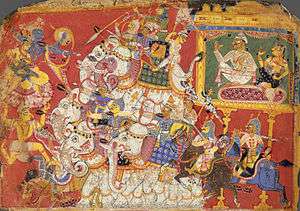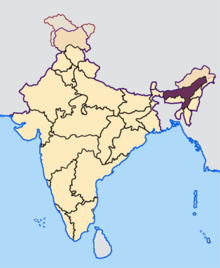Bhauma dynasty
Bhauma dynasty | |||||||||
|---|---|---|---|---|---|---|---|---|---|
| ???–??? | |||||||||
| Status | Legendary | ||||||||
| Capital | Pragjyotishpura (present-day Guwahati) [1] | ||||||||
| Government | Monarchical | ||||||||
| Maharaja | |||||||||
| Historical era | Iron age | ||||||||
• Established | ??? | ||||||||
• Disestablished | ??? | ||||||||
| |||||||||
| Part of a series on the | ||||||||
| Mythology of Pragjyotisha | ||||||||
|---|---|---|---|---|---|---|---|---|
 | ||||||||
| Ruling dynasties | ||||||||
|
||||||||
The Bhauma dynasty is second legendary dynasty of Pragjyotisha, after the Danava dynasty, that has been mentioned in the epics such as the Ramayana, the Mahabharata, the Kalika Purana, the Yogini Tantra and local lore.[2] The dynasty established in Dwapara Yuga, sometime before Mahabharata war, as Bhagadatta, the son of Naraka and also friend of Pandu, fought for Kaurava's. It is the contemporary of Bana dynasty of Sonitpur (central Assam).
According to the 10th-century Kalika Purana, the dynasty was established by Naraka of Videha, by removing the Kirata chief Ghataka, the last of the Danava dynasty.[2][3] The development of the details of the Naraka story are considered as myths[4] though historically he could have been a native Kirata chief,[5] or a Hinduized tribal youth.[6] The glorification and assimilation of a local chief and the making of myths follow a pattern that is observed in other parts of India.[7] The last ruler, Suparua, was killed by his ministers.[8]
Rulers
| Name | succession | Queen | |
|---|---|---|---|
| 1 | Naraka | son of Bhumi and Vishnu | Maya (Princess of Vidarbha) |
| 2 | Bhagadatta | son of Naraka | - |
| 3 | Pushpadatta | son of Bhagadatta | - |
| 4 | Vajradatta | son of Bhagadatta | - |
References
- ↑
- Prakash, Col Ved, Encyclopedia of North-East India
- 1 2 (Gait 1906, p. 12)
- ↑ (sircar 1990, p. 87)
- ↑ "The details of the Naraka legend seems to suggest a development more or less on the mythical lines." (Sircar 1990, p. 84)
- ↑ "It is contended that Naraka was a powerful Kirata chief whose feats had been magnified and myths created to prove his divinity to account for his supposed heroic (mis) deeds" (Das 2005, p. 225)
- ↑ "With the blessings of Vishnu, Narakasura, a Hinduised tribal youth of Videha (North Bihar) destroyed this kingdom with the help of his own tribe and Alpine Hindus after a fierce struggle." (Sen 1984, p. 101)
- ↑ "Just as in other parts of India, in Assam also, social groups and tribes initially considered to be outside the pale of the varnasramadharma had been assimilated into the fold of Aryan society after they had acquired political power. Thus, in the Brahmaputra valley, Naraka, a Kirata chief rose into prominence in the proto-historic period and became so powerful that the tales of his exploits remained in the collective memory of the people." (Das 2005, p. 225)
- ↑ (Gait 1906, p. 14)
Bibliography
- Das, Paromita (2005). "The Naraka Legends, Aryanisation and the "varnasramadharma" in the Brahmaputra Valley". Proceedings of the Indian History Congress. Indian History Congress. 66: 224–230. JSTOR 44145840.
- Gait, Edward A (1906), A History of Assam, Calcutta
- Sen, Debasis (1984). "Ethnic Elements in the Political Life of Ancient Assam". Proceedings of the Indian History Congress. Indian History Congress. 45: 101–106. JSTOR 44140186.
- Sircar, D C (1990), "Epico-Puranic Myths and Allied Legends", in Barpujari, H K, The Comprehensive History of Assam, I, Guwahati: Publication Board, Assam, pp. 79–93
